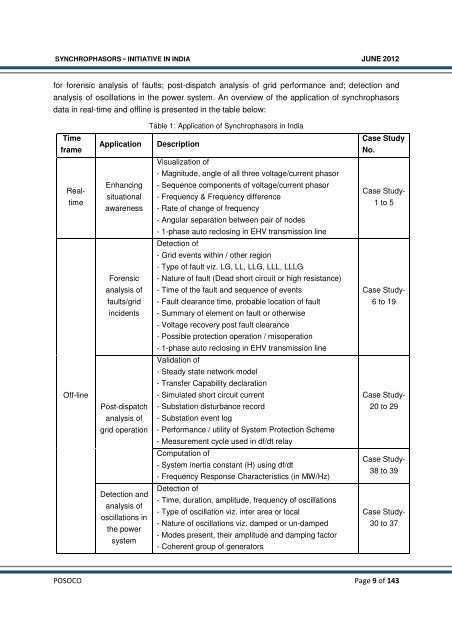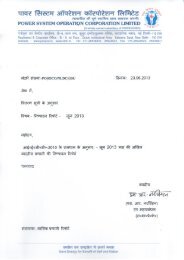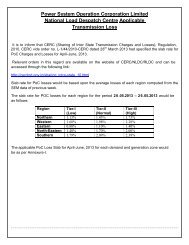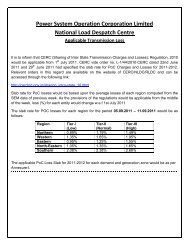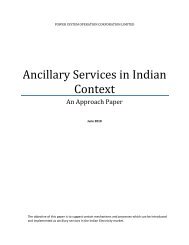Synchrophasor Initiative in India - erldc
Synchrophasor Initiative in India - erldc
Synchrophasor Initiative in India - erldc
Create successful ePaper yourself
Turn your PDF publications into a flip-book with our unique Google optimized e-Paper software.
SYNCHROPHASORS - INITIATIVE IN INDIA JUNE 2012for forensic analysis of faults; post-dispatch analysis of grid performance and; detection andanalysis of oscillations <strong>in</strong> the power system. An overview of the application of synchrophasorsdata <strong>in</strong> real-time and offl<strong>in</strong>e is presented <strong>in</strong> the table below:TimeframeRealtimeOff-l<strong>in</strong>eTable 1: Application of <strong>Synchrophasor</strong>s <strong>in</strong> <strong>India</strong>Application DescriptionVisualization of- Magnitude, angle of all three voltage/current phasorEnhanc<strong>in</strong>g - Sequence components of voltage/current phasorsituational - Frequency & Frequency differenceawareness - Rate of change of frequency- Angular separation between pair of nodes- 1-phase auto reclos<strong>in</strong>g <strong>in</strong> EHV transmission l<strong>in</strong>eDetection of- Grid events with<strong>in</strong> / other region- Type of fault viz. LG, LL, LLG, LLL, LLLGForensic - Nature of fault (Dead short circuit or high resistance)analysis of - Time of the fault and sequence of eventsfaults/grid - Fault clearance time, probable location of fault<strong>in</strong>cidents - Summary of element on fault or otherwise- Voltage recovery post fault clearance- Possible protection operation / misoperation- 1-phase auto reclos<strong>in</strong>g <strong>in</strong> EHV transmission l<strong>in</strong>eValidation of- Steady state network model- Transfer Capability declaration- Simulated short circuit currentPost-dispatch - Substation disturbance recordanalysis of - Substation event loggrid operation - Performance / utility of System Protection Scheme- Measurement cycle used <strong>in</strong> df/dt relayComputation of- System <strong>in</strong>ertia constant (H) us<strong>in</strong>g df/dt- Frequency Response Characteristics (<strong>in</strong> MW/Hz)Detection ofDetection and- Time, duration, amplitude, frequency of oscillationsanalysis of- Type of oscillation viz. <strong>in</strong>ter area or localoscillations <strong>in</strong>- Nature of oscillations viz. damped or un-dampedthe power- Modes present, their amplitude and damp<strong>in</strong>g factorsystem- Coherent group of generatorsCase StudyNo.Case Study-1 to 5Case Study-6 to 19Case Study-20 to 29Case Study-38 to 39Case Study-30 to 37POSOCO Page 9 of 143


